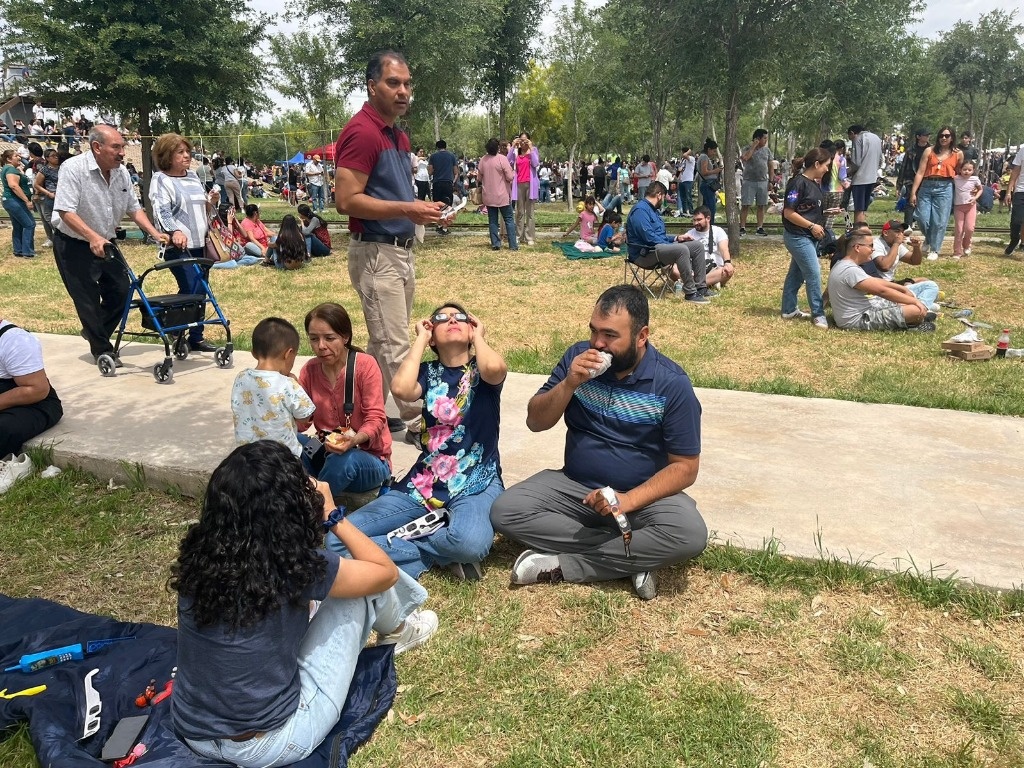Torreon, Coah. More than a million glances look up at the sky: the moon devours the sun, as the Mayans would say, and for a few minutes, the day darkens for four minutes.
So many centuries of this astronomical spectacle and it never ceases to amaze us, the celestial vault reminds us again of our infinite smallness.
About 200 astronomers from NASA and the world installed in the Torreón Planetarium, thousands of people looking out of their windows, children watching from the roofs of their houses: this solar eclipse will not be repeated in Mexico until March 2052.
The urban forest is full. Complete families, with everything and loins, lie down on the grass and, with their certified glasses, look directly at the sun.
Science buffs set up their telescopes and allow curious people to approach them, and others assemble their own with cardboard boxes and small mirrors.
At 55 percent of the eclipse, the sun looks like a bright yellow crescent moon, and people shout and clap, spread their arms and ask for health and abundance; The birds sing and the dogs get upset: the animals begin to show strange behavior.
The moon continues to advance, the sun follows its path; Parents talk to their kids about how awesome it must have been to be a caveman and not understand why it got dark in the middle of the day, and the kids wonder the same thing, and their parents hesitate to explain.
The eclipse is 99 percent. The shouts and applause intensify, the adults cross themselves and thank God; The young people pause the music, the birds fly to the trees.
The sun does not set in the west, and yet it becomes night.
The most exciting, disconcerting, historic four minutes.
“In the next eclipse I’m going to be 45 years old… very old,” says a little boy who still doesn’t fully understand the laws of age and relativity.
At the Torreón Planetarium, NASA headquarters to broadcast the astronomical phenomenon, the mariachi sang El Son de la Negra just when the four minutes of darkness had passed and the solar sphere once again emitted its rays.
The party for the astronomical event was not exclusive to the urban forest and its 18 hectares of vegetation, the lungs of this city; In the Sanctuary of Las Noas, where the majestic image of Christ with that name is located, there was a festival for national and foreign visitors: food stalls, regional music and most importantly, temporary telescopes.
Victoria Martínez came from Monterrey. Her love for the architecture of parishes and cathedrals brought her to this place with her husband and two of her children. “I am 52 years old, I may not be able to reach the next eclipse; I couldn’t miss this one.”
The Plaza Mayor also attracted visitors who before and during the eclipse took the opportunity to tour the center and even enjoy a beer to calm the 29 degrees.
The economic impact and the number of tourists mobilized a thousand state and municipal police to monitor the different areas. A helicopter from the Ministry of Public Security supported with overflights in the sectors with the highest concentration of visitors.
And after the eclipse, what comes next? Hotels and app reservations began to empty. Torreón and the lagoon region return to normal this Tuesday.
#Planetarium #Torreón #NASA #headquarters #broadcast #eclipse
– 2024-04-19 12:04:45
